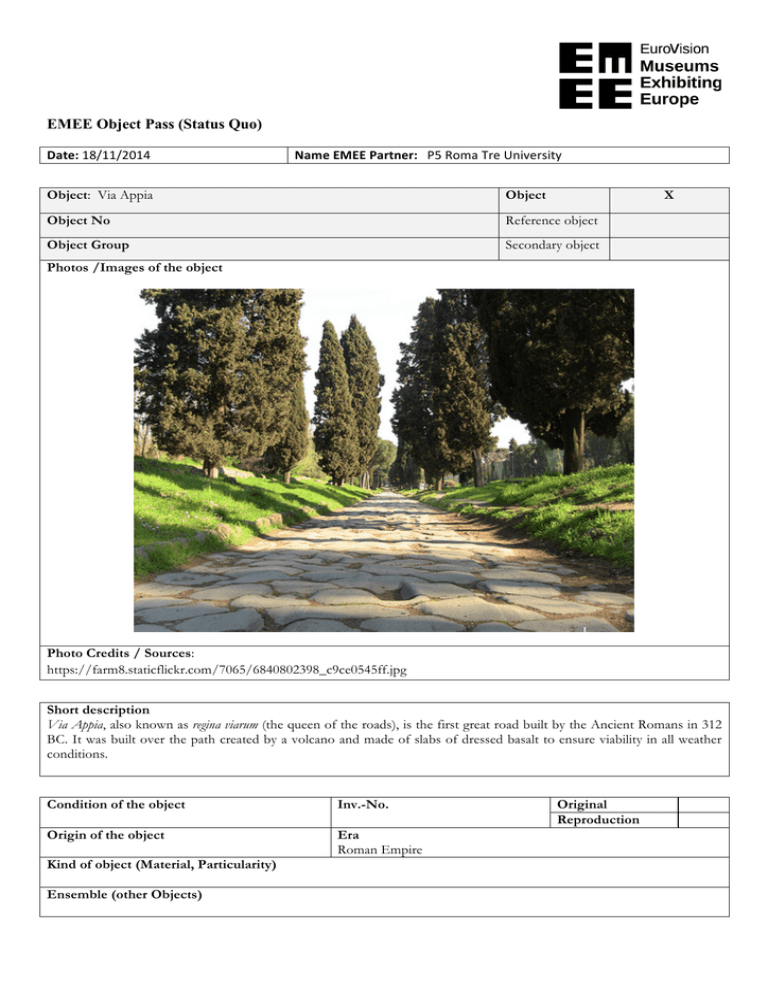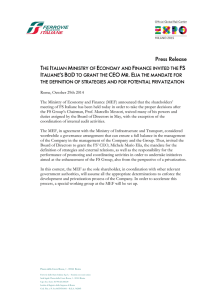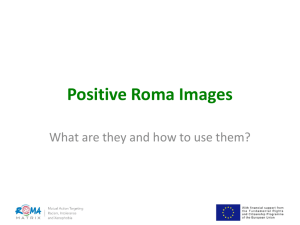EMEE Object Pass (Status Quo) - Young Scenographers Contest
advertisement

EMEE Object Pass (Status Quo) Date: 18/11/2014 Name EMEE Partner: P5 Roma Tre University Object: Via Appia Object X Object No Reference object Object Group Secondary object Photos /Images of the object Photo Credits / Sources: https://farm8.staticflickr.com/7065/6840802398_c9ce0545ff.jpg Short description Via Appia, also known as regina viarum (the queen of the roads), is the first great road built by the Ancient Romans in 312 BC. It was built over the path created by a volcano and made of slabs of dressed basalt to ensure viability in all weather conditions. Condition of the object Inv.-No. Origin of the object Era Roman Empire Kind of object (Material, Particularity) Ensemble (other Objects) Original Reproduction Holder/Lender/Collection Dimension Weight (in grammes) Conservation requirements Presentation requirements Is the object part of a current Exhibition? About the first 10 miles of theVia Appia, starting from Rome, are currently preserved as a Regional Park of Appia Antica. Title of the exhibition area Area number The Park of Appia Antica Current Presentation Situation The Park of Appia Antica includes the first 10 miles of the ancient consular road; this is an archaeological area hosting the remains of Roman aqueducts and monuments dating back to the Republican and Imperial age. Intended Effect/Impact/Presentation Theme/Content The Appian way is chosen as the first example of a network of roads in Europe. History and Significance of the Object /Original context of the object /Reason for presentation Via Appia is the first great road built by the Ancient Romans in 312 BC. It was built by the censor Appius Claudius Caecus to ensure the communication between Rome and Capua during the Samnite wars. The road was the main factor that allowed the Romans to concentrate their forces with rapidity and keep them adequately supplied during the war, at the same time it was also an important commercial route for the Roman empire. National Perspective / Significance Along the Appian way we find traces of the activities carried out by the ancient Romans like villas with agrarian functions and thermal complexes, etc. Stone markers set up on the roadside to indicate the distance in miles from Rome and post stations were located on the road in order to facilitate travel. European Perspective / Significance The Appian way represented a model for the communication routes the Romans built all over their empire. Signs of the activities developed along the way are in common with the ones we find in the great road links built by them and still existing in nowadays Europe. References to Literature and Data that are relvant and that provide background for the object / Bibliographic References AA.VV., Viae publicae Romanae, Roma 1991 (catalogo della mostra). M. Calzolari, Introduzione allo studio della rete stradale dell'Italia romana: l'Itinerarium Antonini, Roma 1996. I. Della Portella, G. Sartori Pisani, F. Ventre, The Appian Way, from its foundation to the middle ages, Getty Publications, 2004. R. Paris (a cura di), La villa dei Quintili, Electa, Milano 2000. R. Paris (a cura di), Via Appia, il mausoleo di Cecilia Metella e il castrum Caetani, Electa, Milano 2000. L. Quilici, Le strade. Viabilità tra Roma e il Lazio, Roma 1991. A. Soletti (a cura di) La via Appia da Roma a Damasco, Roma 2004. R.A. Staccioli, Strade romane, Roma 2003. A.M. Tazzi, Le strade dell'antica Roma. Dal IV secolo a.c. al V secolo d.C. in Europa, Asia ed Africa, Roma 1998









